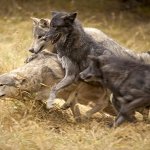Llamas are friendly, delightful and extremely intelligent animals that carry themselves with serene pride. These beautiful animals are of gentle disposition, easy to train and unfazed by people. With their long, silky eyelashes framing big, intelligent eyes, llamas find their way into the lives of many people, in many walks of life, bringing joy to all who are graced by their presence.
Llamas are a herd animal, curious, sensitive, aloof and independent. Many enjoy being scratched or rubbed and spending time with their owners. They can become companions, packers, pull a cart, enter shows and parades, entertain at nursing homes and schools, and golfers think it’s great fun to have a llama caddy. Llamas come in a rainbow of colours and shades – markings can be in a variety of patterns, from solid to spotted. They don’t spook, kick or bolt, and are safe with children. Llamas greet you with a soft sniffing and blowing in your face. The best way to greet a llama is quietly with your hands behind your back and offering your face for inspection. Stand still and let the gentle natured llama approach you.
Llamas are very quiet animals. Humming is their primary means of vocal expression. A llama’s hum sounds similar to a person’s hum. Depending upon the situation, llamas may also cluck, orgle or make an alarm call. All sounds are very distinctive and easily recognizable. It will be clear what llamas are trying to express if you look at their situation and listen.
Llamas live for about twenty years and are easy to maintain. They need a three-sided structure providing shelter from wind, rain, snow and hot sun. Other needs include fresh water and hay, safe fencing and pasture, adequate room to exercise, and most need their toenails trimmed twice yearly.
All llamas are normally trained to calmly accept a halter and lead, load into a trailer, truck or van, accept brushing and shearing, and allow their feet to be handled for trimmings. The llama gestation period is between 335 and 360 days, with 350 days used as a rule of thumb. Baby llamas are called crias, which can be weaned from their mothers at six months.
Vancouver Island has approximately 40 llama farms, with 4 of them located in the Greater Victoria area. Llama farms are becoming increasingly popular, and Bed and Breakfasts located on llama farms add an extra dimension to an already pleasant stay in British Columbia. These lodgings allow guests the exciting opportunity of taking the llamas on quiet walks on nearby trails.
Charismatic llamas have a therapeutic effect on visitors, and it would seem that guests just can’t get enough of them. They feed them, photograph them, cuddle them, and sit, talk and walk with them. It’s nearly impossible to sit quietly with a llama and not find yourself engaged in their special magic. Llamas are to love, to enjoy, and to relax and have fun with.
Do llamas spit?
Usually llamas spit to tell another llama to get out of their space or food. A bred female will spit at males who are trying to approach her, and some llamas will spit at others getting too close to their crias. Rarely will llamas spit at their owners. If they do, it is usually in fear or pain and often means the handler is at fault. Spitting at humans is the exception not the rule.
Llamas For Therapy
Llamas instinctively learn to be quiet and gentle with the weak or handicapped, making them great therapy animals. They are naturally curious and alert, have beautiful, large eyes and interact with a new person with a genuine interest. Llamas seem to have a certain sense that some people are special, and don’t react negatively to cumbersome movements or unusual speech, which is why handicapped people respond so positively to llamas. Some doctors have recommended the use of llamas with high stress patients who need to relax, and others are using llamas in therapy work with handicapped adults and children. Llamas have also been recommended by psychologists and doctors as stress reducers for people with very active lives.
Llamas For Packing and Trekking
The llamas’ ability as a pack animal has been rediscovered by hikers and forest work crews in mountainous areas and wilderness parks in North America. Capable of carrying 50 to 100 pound packs and travelling 10 to 15 miles a day, llamas are agile and blessed with common sense. Being smaller than most pack animals, and with their padded feet, llamas have minimal impact on the backcountry environment and require far less to drink. The llamas’ unique two-toed foot, with a broad leathery pad on the bottom and curved nails in front, makes them remarkably sure-footed on a variety of terrains, including sandy soil, rock and snow. Thanks to the easygoing nature of the llamas and by helping with the load, llamas can open up the wilderness to day-long treks or overnight camping for those whose fitness may prevent them from carrying their own equipment, allowing a one-on-one relationship with their pack companion. Llamas can also be trained to pull carts and wagons.
Lamas in Education
Many llama projects educate young people in the raising, breeding and training of llamas. The unique and gentle nature of the llama nurtures the growth of children’s self esteem and allows them to share their knowledge and companionship through nursing home and school visits, parades, and other community events.
Llama Fibre
One of the most treasured by-products of llamas is their exquisite fibre. Llamas have wonderful fine fibre that is soft and warm, sheds rain and snow, and rarely shrinks when washed. Hand spinners, knitters and weavers all appreciate the softness and warmth of llama fibre, creating beautiful garments. The variety of natural colours and the absence of lanolin are other desirable qualities. Llamas can be shorn annually or biannually depending on preference and growth rate. Llama fleece normally grows 3 to 4 inches per year with a full grown coat averaging 5 to 10 pounds. Llama fibre can range from short to long, coarse (good for bags, rugs, felting and ropes) to extremely fine (wonderful for sweaters, hats and scarves) and has a tensile strength and durability three times stronger than a wool strand.
Llamas As Guards
Llamas have proven themselves to be marvellous guardians of livestock. The effective use of llamas as sheep guards began in North America in the early l980s, with more than half of the llamas guarding sheep achieving a 100% rate of success, completely eliminating losses. Many livestock farms have successfully used llamas to guard flocks of 200 to 1,000 meat, wool and milk producing animals in all types of terrain and pastures sizes. Guard llamas work well in teams of two. The value of livestock saved each year often exceeds the purchase cost and annual maintenance of the llama.
Llamas for show
These intelligent animals are judged for conformation, balance, structure and performance. Showing llamas has become a favourite family affair now that hundreds of llama events are held across Canada and the United States. Today the show circuit is enhanced with local, regional, and national shows.
Llama History
Archaeological evidence indicates that the llama and alpaca were domesticated in Peru about 6,000 years ago. One theory suggests that the llama was domesticated from the wild guanaco, and the smaller alpaca from the wild vicuna. In pre-Inca times, certainly by the 11th century AD, sophisticated breeding and management systems were preserving and perpetuating the integrity of the subspecies – breeding animals of supreme quality, ideally suited to their various purposes. The Incas placed prime emphasis on alpaca breeding, as at that time fibre and textiles were of great economic importance. The llama had been bred for use as a beast of burden in addition to their fine fibre. In the late 1800s and early 1900s, private animal collectors and zoos reintroduced them to their original North American homeland.


